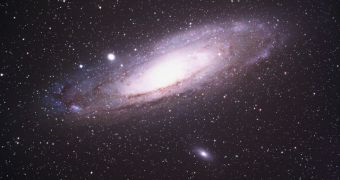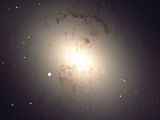Believe it or not, most of the stars and cosmic objects in the visible universe are actually impossible to observe with the naked eye. Only a handful of galaxies and star clusters in the near vicinity of our galaxy can be spotted without the help of optical tools. More than 99 percent of the stars viewed on the night sky are part of our home galaxy, the Milky Way.
But what is a galaxy? The Milky Way represents only a small part of the whole matter in the universe. It consists of an accumulation of a few hundred billion stars, forming a disk-like structure which is held together by the gravitational pull. This galactic disk presents a curved area in its center, visible in the direction of the Sagittarius constellation, where the so-called galactic nucleus is located. The galactic nucleus consists in a large population of stars densely packed into a relatively small volume, orbiting at incredible speeds a supermassive black hole, dead in the center of the galaxy.
Similarly to the water draining through a sink hole, the galactic disk presents whirlpool-like features, meaning that stars are distributed in galactic arms forming a spiral structure. At least that is the case of our Milky Way, as other galaxies might take a globular or elliptical shape. Our solar system is located in one of these galactic arms called Orion Cygnus, between the Perseus and the Carina-Sagittarius arms.
A galaxy represents an extremely large structure relatively to the size our planet or the solar system. Our Milky Way is approximated to have a diameter of about 100,000 light years in diameter, and our Sun is located at about 30,000 light years away from the galactic core. For such a structure to complete a rotation around its axis it would take more than 225 million years, a so-called cosmic year.
Similarly to stars, galaxies pull together in large groups with the help of their gravitational fields. Our galaxy is a part of such a group, consisting in the Magellan's clouds, the Messier 31 or the Andromeda galaxy, and about 30 other galaxies.
The galactic core of the galaxy contains mostly old stars or Population II stars, representing the second generation of stars that formed since the Big Bang. There are mostly old stars, which formed more than 12 billion years ago, while our star is a part of the Population III of stars with relative high metalicity. Aside the stars in the center of the galaxy and those in the arms of the whirlpool, some stars may wonder in halos outside these structures, most of the time spinning in a direction contrary to that of the galactic disk, either ejected through gravitational interactions with the supermassive black hole in the center of the galaxy, or captured by the galaxy while passing through the vicinity of another.
While these structures compact all the matter visible in the universe, it seems that there is an extra gravitational pull exerted by these cosmic objects that cannot be explained by current physics. The general belief implies that the normal matter in the universe is only 4 percent of the total mass present while the rest is represented by dark energy and dark matter, which so far remains largely undetected.

 14 DAY TRIAL //
14 DAY TRIAL // 
